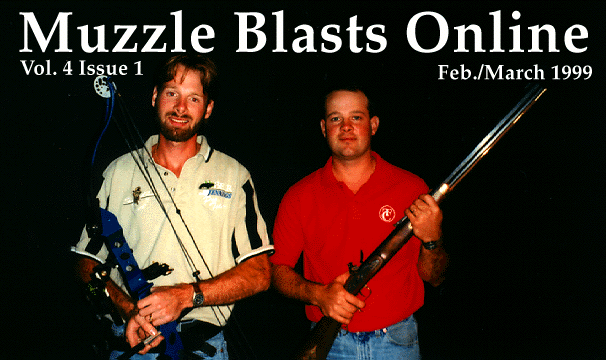Touched By Fire
by Parson James Burow
One night, at an Eastern rendezvous, the dishes were done, the guests had left, and we decided to take a walk
and go visit some friends.
As Providence would have it, they were not home. We tried another camp; they too were not home. It was
late now and we decided to return to our lodge. When we turned around, we saw a tent on fire, just starting
to burn above the stove pipe. For an instant we were not sure we were seeing what we were seeing.
Beth yelled "Fire, fire," as we both started running toward the tent. Beth ran to the front of the tent, where
a good number of buckskinners were talking and having a grand old time. They had no idea the back of the
tent was on fire.
I stayed where the fire was, so no one would run past me and miss exactly where the water was needed.
While I was waiting, I looked around and absolutely no one was on the main road. All the camps were dark
or empty. I could not believe that in a rendezvous with approximately three thousand people, help would not
be coming from all directions. But where fire is concerned, assumptions can not be made.
A buckskinner arrived with a bucket of water and put out the fire. We got it out just before the flames would
have caught the roof and dozens of tents nearby. Little damage was done - about fifteen square inches - and
a neighbor gave the tent owner a spare piece of canvas to patch the hole.
Until this fire, I had never given stoves, stove pipes, and fires a second thought. After the eastern in Tioga,
New York, where we had rain, snow, sleet, and hail, I bought a stove.
Walking home Beth said, "people who sell stoves just sell stoves, no instructions." Perhaps some do come
with instructions, but mine didn't!
Historically, I have never seen or read of a mountain man having a iron or steel stove and pipes strapped to
the back of one of his pack animals. So when we decide to put something that gets very hot into something
that readily burns, we take on an awesome responsibility.
This fire scared me. Suddenly questions like, "will my stove be safe?" and "what do I know about installing
a safe stove?" took on a whole new meaning. How close we came that night to a major camp fire! God helped
us with this fire because there was no wind and it was caught in time.
The purpose of this article is to help prevent camp fires. First, those of us who have stoves need to make sure
they will not catch our tent or someone else's tent on fire. The key is safe set up. Second, if you have yet to
install a stove into your lodge, you need do so safely.
There are no doubt many ways to install a stove safely. But one safe option even before we get to a stove is
the tent itself. Tents now come with fabric that is made flame retardant. I understand they don't burn, but they
do melt. Your tent supplier can more accurately explain the details of this type of fabric.
This is not to suggest that we don't have to be careful with fire and heat in using this type of flame retardant
fabric. Nor can we omit the need for a safe stove pipe insert.
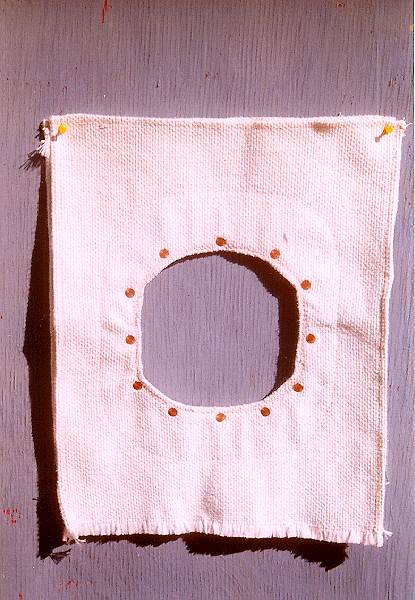
|
|
Figure 1
|
This is the next area we need to look at. One type of insert is a "Fiberglas stovehole insert." They come in
diameters of three, four, five, and six inches. The supplier must know the size of your stove pipe before an
insert can be made up for you. Panther Primitives currently sells inserts for $30.00, and you install them. If
they install the insert, the cost is $37.50, which does not include shipping. Panther can be reached by calling
(304) 462-7718. Figure 1 shows this type of insert.
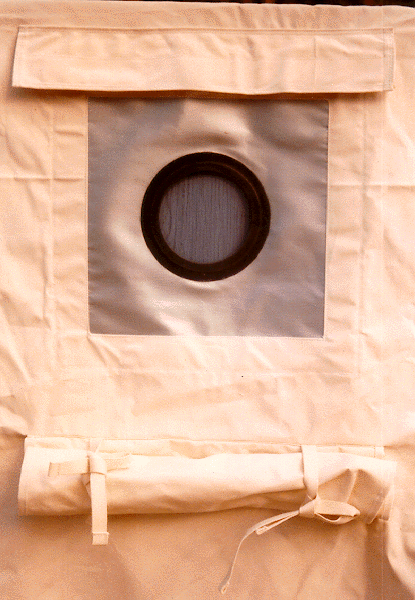
|
|
Figure 2
|
Another type is the current U.S. Military Special issue stove jack. This is a "coated woven silicone panel with
a black silicone ring in the center." The unit can not melt or burn, and the hole size is determined by the
diameter of your stove pipe.
When the stove is not needed, a waterproof cover flap seals the hole from rain and wind. This flap is held
in place by a three-inch strip of Velcro® which is completely hidden from sight by a top flap.
When the pipe is inserted through the hole, the covering flap is rolled down, completely hiding the Velcro®,
and is tied on each side with straps.
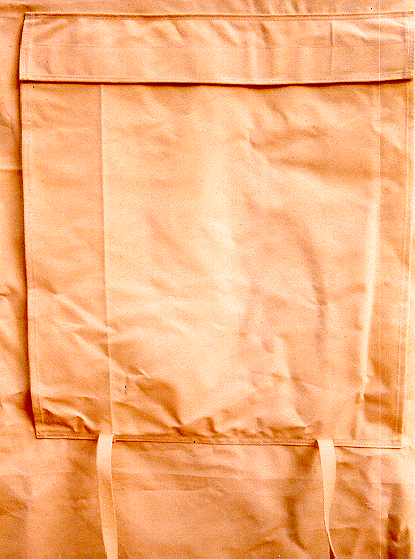
|
|
Figure 3
|
Peter Marques of Tentsmiths sells these inserts with the added safety feature of the covering flap rolling
down and tying under the stove pipe. We can and should use this technique for our tents. Typically, flaps are
rolled up and tied. If wind should vibrate the flap loose, it would fall onto a hot pipe and could start a fire.
Rolled down and tied under the pipe, if it comes loose, it falls away from the hot metal, thus adding one more
safety feature in fire prevention.
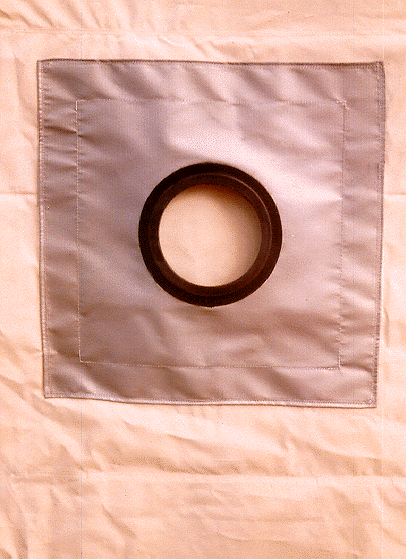
|
|
Figure 4
|
This insert comes in two shapes: oval and round. The oval sizes are 4 1/2, five, and six inches. The round
sizes are, three, four, five, and six inches.
Tentsmiths sells this unit for $30.00; this is for the gray material with the black ring only. If you want the
canvas material sewn around it, with the flap and ties, the cost is $40.00. When you order one of their tents,
they will install the insert with the canvas and flap for $55.00. Tentsmiths can not install this unit into tents
made by other manufacturers. To order, they can be reached by calling (603) 447-2344.
Figure 2 shows an outside view, ready for insertion of a stove pipe, in the open position. Figure 3 is an
outside view, closed when stove is not needed. Figure 4 is an inside view with the flap closed.
Our next area of concern is the pipe itself. If you want added safety in this area, then making an insulator
pipe that goes around the stove pipe is the way to go.
The insulator pipe is larger and provides a dead air space between the stove pipe and the fireproof insert.
This outer pipe can remain at very low temperatures when the stove pipe may be very hot.
To make one it is best to take your stove pipe to the hardware store. For example, my stove pipe is five inches
in diameter. The size pipe I needed to go around it and give me a dead air space was seven inches.
Before I put the seven-inch pipe together, I cut a sixteen-inch length while it was still flat. This will be the
insulator pipe that will go through the tent wall and around the stove pipe.
There are two ways to affix this outer pipe to the stove pipe. One is to have someone tack weld three to four
steel "rails" to the inside of the insulator pipe only. These rails take up the space between the outside of the
stove pipe and the inside of the insulator pipe. The rails make it possible to slide the insulator pipe on and off,
if this is an advantage to you.
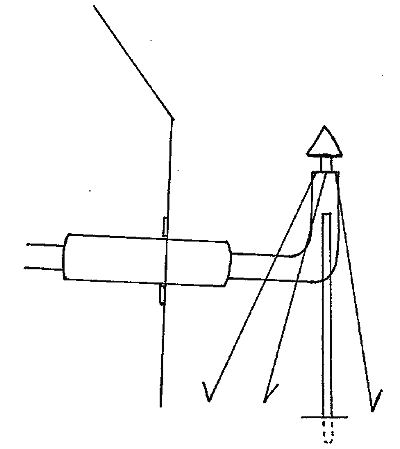
|
|
Figure 5 - Stove pipe secured outside tent.
|
If your stove pipe is on any kind of angle, or if it goes straight through the roof, it will slide out of position.
This method is not recommended unless your stove pipe is horizontal. (Fig. 5).
Even though this insulator pipe will be much cooler than the stove pipe itself, you will still need a safe stove
pipe insert.
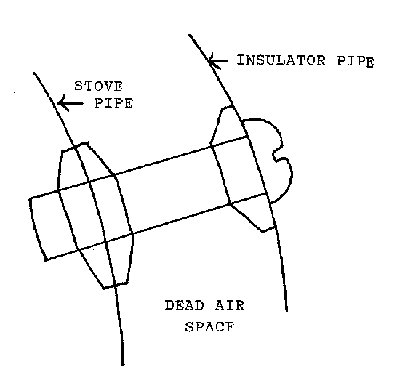
|
|
Figure 6 - Nut and Bolt Standoff
|
A second permanent way to attach the outer pipe is with a series of matching holes in both pipes. Nuts and
bolts are threaded through holes that, when tightened, secure the outer pipe. Figure
6 shows the nut-and-bolt arrangement.

|
|
Figure 7 - Insulator Pipe Assembly
|
Figure 7 is the stove pipe and insulator pipe installed around it.
This outer sixteen-inch-long insulator pipe, with the dead air space, going through a fire-retardant liner or
stove jack, should keep any cotton canvas tent from catching fire.
The outside, rising stove pipe should be at least eighteen inches from the tent wall. All pipe sections should
be secured with sheet metal screws so they will not come apart in the wind. It does get windy at rendezvous,
especially when I am preaching.
Use good, sturdy steel rod screwed or bolted to the entire outside pipe. Sink this rod about eighteen inches
into the ground. For added safety, attach three wire guide lines, coming off the top of the pipe. Stake these
to the ground to keep the entire pipe from being blown over onto your tent or your neighbors' tent. Mechanic's
wire should work well for this. (Fig. 5)
I have never seen a stove pipe cap with a replaceable screen in it to retard sparks. Overnight and in wind,
sparks can fly out and land on a tent roof. I understand that if one camps in a national forest and uses a stove,
it must have a screen-capped pipe. Perhaps this might be an item worth making, if someone doesn't already.
Now we come to setting up the stove inside the tent. In this area, Peter Marques suggested I contact Donald
Kevilus, a stovemaker and proprietor of "Four Dog Stove Company." He can be reached at (612) 444-9587.
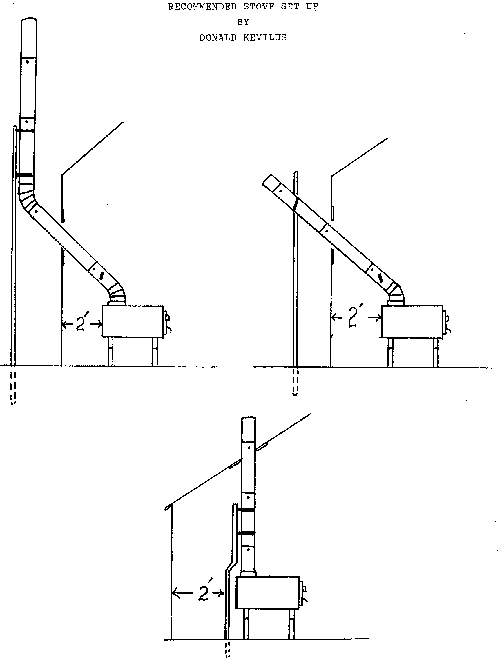
|
|
Figure 8 - Don Kevilus's three safe stove set up arrangements.
|
Don makes a four-dog, a three-dog, and a two-dog stove. They are perfect for our needs and extremely well
designed and constructed. (Fig. 8)
My article is not about cooking. But one added blessing about Don's stove is this: on deep, dark, dank,
dreary, drizzly, depressing, damp rendezvous days, you can cook on them along with keeping your lodge
safely toasty warm.
Underneath the stove is a fire waiting to happen if it's sitting on dried grass or a canvas floor. I have seen
charred and burned holes in a tent floor where embers got out through the air vent in the door.
The following are Don's recommendations that he was kind enough to share with all of us: 1) buy a stove
board for under the stove from your hardware store, or... 2) build a floor box out of plywood, with a rim made
from two-by-two around the perimeter. Fill this evenly with two inches of sand and set the stove in this box.
3) When burning your stove it is better to burn a small, hot fire, adding small pieces three to four inches in
diameter, than a large, smoldering fire. 4) On a new stove, burn it outside the first time to cure the paint. 5)
When fueling your stove, always rake your coals forward before adding new wood. 6) When fueling for the
night, always have a good bed of coals before filling the fire box with wood 3" to 4" inches in diameter; you
will have a nice steady heat for the night. 7) When using charcoal or coal, either put a layer of sand or have
a bed of ash in the bottom of the stove and keep the coals in the center. 8) Never put your stove away with
ashes in the fire box.
Remember, these points apply to stoves made by Don. But we can use them to make our stoves safe or safer.
When you buy a four-dog stove, along with the instructions, you will get these eight basic safety guidelines.
Rule 1: First and foremost, think safety! You can never be too safe.
Rule 2: Never have any combustible material closer than eighteen inches from the perimeter of the stove and
twenty-four inches from the top.
Rule 3: Use only a safe stove pipe jack. Never allow stove pipe to come in contact with your tent.
Rule 4: Exercise caution in handling stove pipe; it may have sharp edges.
Rule 5: When setting up stove pipe always, make sure it is secure so it will not come apart in high winds or
if bumped.
Rule 6: Never leave the stove unattended with children, or the door open to the stove. Hot stoves can cause
burns.
Rule 7: Always make sure your coals and ash are out when you empty your fire box.
Rule 8: Think safety!
Don mentioned two more important maintenance practices designed to add years of use to one's stove. First,
do not store the stove with ashes in it. Ashes will attract moisture and combine to make lye, an acid. We do
not want the fire falling through the stove bottom, starting a fire.
Second, at the end of each season, wire brush any rust and paint the outside with high-heat barbecue paint.
Up here in New Hampshire, we burn wood all winter and have for eighteen years. Each spring, creosote must
be cleaned off all stove pipes and the chimney liner. My brother-in-law is a fireman and he tells me burning
creosote or "chimney fires," get hot enough to make bricks glow cherry red. After each rendezvous season,
please clean the stove pipes. After each rendezvous, check the pipes for creosote build up.
Wood! More than one booshway has told me their wood has been cut one year ahead. This means good, hot,
smoke-free fires. But when it is dumped in open piles on site several days before the event and it rains, the
wood soaks up water like a sponge. I know of one couple who decided to lay the wet wood up against their
stove during the day to dry it out. Their tent burned down.
It would be wise if some waterproof covering could be put over these piles of wood, at least until the
rendezvous started. It is worth preserving all that bone-dry wood and the time it took to get it that way.
One buckskinner told me he cuts up hardwood boards into four- or five-inch-long pieces. These are very
neatly stacked into three or four cardboard boxes. This wood starts all his fires and cooks all his food. He
simply adds larger logs from the rendezvous if needed when the fire is ready. A radial arm saw can make
filling up a cardboard box quick and easy. Watch your fingers, and especially your thumb.
No article on fire would be complete without mentioning water. It is heavy stuff, almost sixty-five pounds
per square foot. This is one reason why it is no fun to continually haul it into camp.
But it was the NMLRA Rendezvous Rule number eight that saved that and a lot of other tents that eventful
night when we were touched by fire. It says under Fire and Wood: "All fires must be contained in a pit and
attended at all times. A minimum of two gallons of water in an open container must be kept within five feet
of the fire. Being in your lodge does not constitute tending the fire..."
I would suggest for our continued safety that the dog soldiers, who do a fantastic job and can never be
thanked enough, check not only fires, but also stoves, pipes, and liners, if they do not already do so.
For each of us, if we have a stove, how safe is it? Do not
assume it will not catch your tent on fire;
make sure
it won't. May God bless you all.
[Editor's note: If your camp set-up is anything like mine, you may hang your firearms and powder horns
from hooks suspended from the tent ridge pole. That keeps them safe and out of the way. Clearly, if you add
a stove to your tent, you must keep such items as far from the stove and pipe as your tent allows.]
References:
Four Dog Stove Company (612) 444-9587.
Panther Primitives (304) 462-7718.
Tentsmiths (603) 447-2344.
